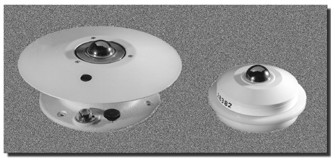

The upward flux radiated by the sea surface is often nearly balanced by the downward flux radiated principally by the moisture in the atmosphere, but the difference can be significant. The sea surface radiation is computed by assuming that the ocean radiates as a gray body, i.e., the upward flux is proportional to the fourth power of the sea surface absolute temperature expressed in degrees Kelvin (K). Ideally the temperature of the top few millimeters would be used, but its measurement from a buoy is exceedingly difficult. Over large parts of the ocean this "skin" temperature varies by less than 0.5 K from the temperatures measured from our buoys at 0.5 m or more below the surface, but in some areas it can be as much as 4-5 K. A correction to this bulk temperature is made to closely approximate the skin temperature (Fairall et al., 1996).
The downward flux is measured with a pyrgeometer. There is only one commercially available pyrgeometer which comes close to being suitable for our measurements. The Eppley Laboratory in Newport, RI, developed the Precision Infrared Radiometer (PIR) in 1970, and it has been used widely ever since. The active part of a PIR is a blackened disk mounted under a silicon dome with an interference coating on the inside. The disk sits on top of one end of a thermopile, the other end of which is in thermal contact with the instrument body. There is a thermistor embedded in the body and another cemented to the inside of the dome near its base. As delivered by Eppley, the PIR has a battery-powered circuit which combines the output of the body thermistor and the thermopile to give a voltage proportional to the long-wave flux. As several investigators (Albrecht et al., 1974; Enz et al., 1975; Albrecht and Cox, 1977) have shown, ignoring the effects of the dome radiating to the disk leads to errors of order 10% under sunny conditions. In addition, the Eppley circuit provides only an approximation to the flux, and their calibration method is of unknown accuracy. There are no other facilities in the US which can provide calibrations for the PIR routinely.

Figure 1. Imet PIR on the right and standard Eppley PIR on the left.
The standard model of the PIR is constructed of bronze, stainless steel and aluminum and has a somewhat fragile, thin aluminum plate to shield the body from solar radiation. Because we foresaw severe corrosion problems and experienced damage during deployment and recovery with this construction, we redesigned it to be built entirely of aluminum and to avoid the fragile radiation shield. The figure shows a standard PIR and our design. Eppley manufactures a model of the PIR to our specifications for us which can be ordered by anyone. Our design, in addition to solving the corrosion and fragility problems, connects conveniently to the IMET(Improved METeorological) electronics cases. Our comparisons of the two models show that ours has slightly better performance than the standard model, probably because aluminum has better heat conductivity than bronze or stainless steel.
Dr. Steven Anderson of the UOP group and I have reanalyzed the PIR and derived a new equation for describing its behavior in terms of body and dome temperatures and the thermopile output. We have scrapped the Eppley battery-powered circuit and now record these parameters directly. With our new equation it was possible to develop a technique for calibrating the PIR and, after doing repeated calibrations on our PIRs, we now feel confident in our technique. The combination of all three advances gives us downward long-wave fluxes of which we feel much more confident.
This is not the end of the PIR development story. A group at the World Radiation Centre in Switzerland (Philipona et al., 1995) has showed that the single thermistor at the base of the dome does not characterize the average dome temperature well, and they are mounting three thermistors around the dome. Additionally, we find that there should be added to our equation a term proportional to the short-wave radiation. We hope to acquire the equipment to evaluate this term within the next year. Dr. Anderson and I have received a grant from WHOI to explore some ideas we have for building an improved long-wave sensor.
Dr. Richard Payne is a Research Associate in the Physical Oceanography Department and a member of the Upper Ocean Processes Group at the Woods Hole Oceanographic Institution.
 Return to UOP Homepage
Return to UOP Homepage